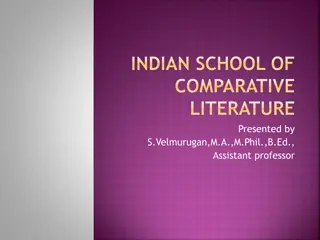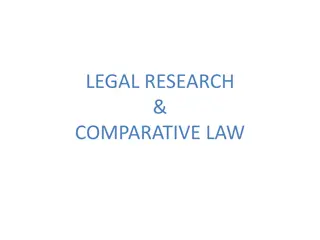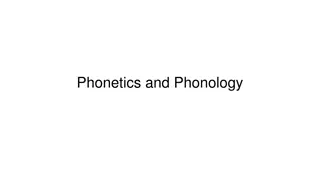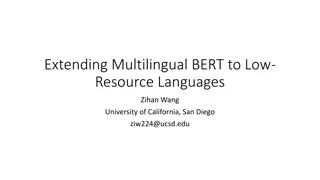Comparative Study on Mongolic and Tungusic Languages
Explore the fascinating linguistics of Mongolic and Tungusic languages, delving into their historical sources, internal reconstruction, morphology, syntax, and class markers. Discover the parallels and differences between these language families, analyzing aspects such as sound systems, lexicon, and plurals. Uncover the intricate structure of countable objects and uncountable masses, as well as the plural forms and ethnonyms of these languages. Engage with the rich linguistic heritage and shared patterns of Mongolic and Tungusic languages through this detailed comparative study.
Uploaded on Sep 27, 2024 | 1 Views
Download Presentation

Please find below an Image/Link to download the presentation.
The content on the website is provided AS IS for your information and personal use only. It may not be sold, licensed, or shared on other websites without obtaining consent from the author.If you encounter any issues during the download, it is possible that the publisher has removed the file from their server.
You are allowed to download the files provided on this website for personal or commercial use, subject to the condition that they are used lawfully. All files are the property of their respective owners.
The content on the website is provided AS IS for your information and personal use only. It may not be sold, licensed, or shared on other websites without obtaining consent from the author.
E N D
Presentation Transcript
Sources on the history of Mongolic Philology Middle Mongol and Written Mongol Linguistics Mutual comparison of the modern Mongolic languages External comparison of Mongolic with Para-Mongolic / Khitanic External comparison of Mongolic with Turkic and Tungusic Internal reconstruction of Mongolic / Proto-Mongolic
Internal reconstruction Dissecting synchronically indivisible words Discovering repeating elements and patterns Identifying lost component structure Lexicalized compounds Obscured derivatives Petrified forms Robert Austerlitz 1923 1994
Mongolo-Tungusic parallels General typology: syntax, morphosyntax Sound systems: phonology, phonotactics Lexicon: a few basic words, e.g. *moo tree, wood Lexicon: a few cultural items, e.g. * rke door Lexicon: a large corpus of borrowings: Doerfer 1986 Morphology: some borrowings Mo > Tu Morphology: a few shared systematic patterns
Class markers countable objects uncountable masses *mo-d.u/n tree *xo-d.u/n *x -d. /n *so-d.u/n *ni-d. /n *si-d. /n *u-s.u/n * -s. /n *to-s.u/n *c -s.u/n *n -s.u/n *ca-s.u/n *x -s. /n *ya-s.u/n water milk oil blood mucus snow hair bone star feather quill eye tooth cf. PL *-d, Tungusic *-k-tA cf. PL *-s, Tungusic *-k-sA
Tungusic plural Vowel stems: *-l Consonant stems: *.V-l Nasal stems: *-r beye : beye-l juug : juug.i-l oro/n : oro-r Secondary: *-sA-l 2 *j -r daa.r fathom beye : beye-sel Nanai juer Nanai daa/r
PL *-r in ethnonyms Daghur -r < *-d Bulghar Turkic -r < *-s Turkic PTCP -V.r Tungusic *-r Jucher Oghur Bulghar Samar Ambiguous Obscure Tatar Avar etc.
Mongolic PL *-r Turkic *em n- front *eb .r front *ebe.r horn/s k k -z b -z [*koxur fiddle kopu-z] *nek n > Ew nekun *naxun [r. Nonni] *nek .r friend *naxu.r lake
Face Pre-Proto-Turkic Pre-Proto-Bulgharic Mongolic Mongolic Common Turkic Mongolic PL *d -s face *d r/i *d ri shape, look *d r-s /n shape, form *y z > *j z *j s. /n complexion, colour Mongolic Nanai Finnish PL *n xu-r PL dere-l : dereg- PL kasvo-t
Reflexive marker Written Mongol ber vs. Proto-Mongolic * xer Daghur een < *exen : weer < * xer Pre-Proto-Mongolic *epen : * per < *epe/n : *epe-r Mongolic Tungusic ABS PL RX SG RX PL *e.pe-n *e.pe-r *-pA-n > *-xAn *bee-n > *mee-n *bee-r > *mee-r *-bA-(y)I > *-bII *-bA-r-I
Etymons with *-r 2 *ji-r- 3 *gu-r- 4 *d -r- 10 *pa-r- *koxa.r pair > 2 *kaca.r cheek/s *kaba.r nose *gar hand/s, arm/s *ka-pu-r spring *na-pu-r autumn cf. *po/n time
Cf. Turkic *-s > -z/-r 1PL bi-z : PX -miz 2PL si-z : PX iz VX 1PL -z ag -z mouth, lip/s b i-z cheek/s b -z horn/s di-z knee/s g -z eye/s k k -z breast/s omu-z shoulder/s yam -z groin y -z face y ld -z star 2 iki-z twins 8 seki-z 9 toku-z 30 otu-z 100 y -z
Mongolic plural Early primary? SG */n : *-r Early secondary SG */n : Early secondary SG *-V- *-d *-s cf. Turkic Late secondary Late tertiary Late quaternary +nAr *-U.d *-nUxU-d etc.
What about *-l? Turkic ag -z *uru(xu).l lip/s *dexe.l clothes *gutu-l shoes (p.c. P. Rykin 26 Jan 2024) *suda-l : *suda-su/n vein
Conclusions Tungusic *-r old, productive, widely attested but: diachronically enigmatic Mongolic *-r marginal, non-productive, residual but: remains a vague possibility























